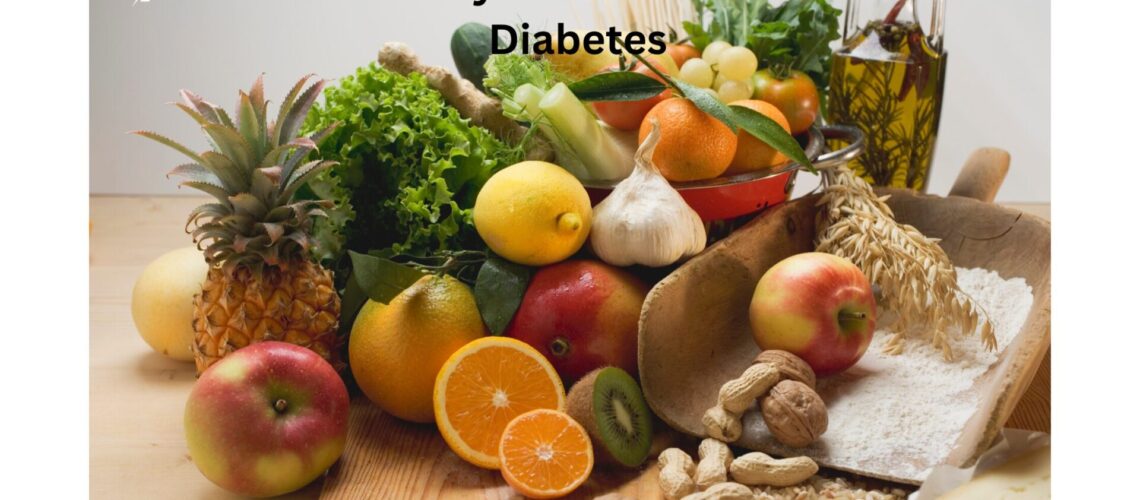
For individuals with diabetes or those trying to manage blood sugar levels, diet plays a critical role in controlling glucose spikes and long-term health outcomes. One of the most effective dietary strategies for maintaining stable blood sugar levels is focusing on low glycemic foods for diabetes. The glycemic index (GI) is a ranking system that measures how quickly a particular food causes blood sugar to rise after consumption. Low glycemic foods are those that are digested and absorbed slowly, leading to a more gradual increase in blood sugar levels, making them ideal for people with diabetes.
In this comprehensive guide, we’ll explore the benefits of low glycemic foods, how they help control blood sugar, and provide detailed lists of the best low GI options. We will also dive into practical tips for incorporating these foods into your daily diet, along with recipe ideas, meal planning tips, and the importance of balancing macronutrients for optimal blood sugar management. Let’s begin by understanding how the glycemic index works and why it matters for diabetes management.
What is the Glycemic Index?
The glycemic index (GI) is a numerical scale that ranks carbohydrate-containing foods based on how much and how quickly they raise blood sugar levels. Foods are categorized as low, medium, or high glycemic, depending on their score on the index:
- Low GI: Foods with a GI of 55 or lower
- Medium GI: Foods with a GI between 56 and 69
- High GI: Foods with a GI of 70 or above
Low glycemic foods take longer to digest and release glucose more slowly into the bloodstream. This helps prevent the rapid blood sugar spikes and subsequent crashes that can be dangerous for people with diabetes. High glycemic foods, on the other hand, cause blood sugar levels to rise quickly, making them harder to manage for individuals with insulin resistance or type 2 diabetes.
The GI score of a food can be influenced by several factors, including:
- Type of carbohydrate: Simple carbohydrates like sugars tend to have a higher GI, while complex carbohydrates like fiber-rich grains have a lower GI.
- Cooking methods: Boiling, baking, or steaming foods tends to result in lower GI scores than frying or roasting.
- Processing: Whole foods like fruits and vegetables generally have a lower GI than processed or refined foods.
- Ripeness: The riper a fruit or vegetable is, the higher its glycemic index. For example, a ripe banana will have a higher GI than an unripe banana.
Why Low Glycemic Foods are Important for Diabetes
For individuals with diabetes, the ability to manage blood sugar levels is critical for avoiding complications such as heart disease, nerve damage, kidney issues, and vision problems. Low glycemic foods help keep blood sugar levels stable by providing a slower, steadier release of glucose, which helps reduce the risk of hyperglycemia (high blood sugar) after meals.
Benefits of Low Glycemic Foods for Diabetes
- Improved blood sugar control: Low GI foods cause a more gradual rise in blood sugar levels, which is easier for the body to manage. This reduces the risk of blood sugar spikes and helps maintain steady glucose levels throughout the day.
- Enhanced insulin sensitivity: Low glycemic foods improve the body’s sensitivity to insulin, making it easier for cells to absorb glucose from the bloodstream. This is especially important for people with insulin resistance.
- Longer-lasting energy: Because low GI foods are digested slowly, they provide sustained energy and reduce feelings of hunger between meals, helping to prevent overeating and weight gain.
- Lower risk of heart disease: Consuming low glycemic foods can help lower cholesterol levels, reduce inflammation, and improve overall cardiovascular health—all of which are critical for people with diabetes who are at higher risk of heart disease.
- Weight management: Low glycemic foods tend to be more filling, which can help with weight management by reducing calorie intake. Maintaining a healthy weight is key for managing diabetes.
Best Low Glycemic Foods for Diabetes
Below is a list of some of the best low glycemic foods that should be included in a diabetes-friendly diet. These foods have been shown to help manage blood sugar levels, promote insulin sensitivity, and provide essential nutrients for overall health.
1. Non-Starchy Vegetables (GI: 15-55)
Non-starchy vegetables are excellent low glycemic foods for diabetes as they are packed with fiber, vitamins, minerals, and antioxidants. They are also low in calories and carbohydrates, making them perfect for managing blood sugar.
Examples of low GI vegetables:
- Spinach (GI: <15)
- Kale (GI: <15)
- Broccoli (GI: 10)
- Cauliflower (GI: 15)
- Bell peppers (GI: 15)
- Zucchini (GI: 15)
- Carrots (GI: 39 when raw)
These vegetables provide a wealth of nutrients without causing significant blood sugar spikes. Aim to include a variety of non-starchy vegetables in every meal to ensure you’re getting a broad range of vitamins and minerals.
2. Whole Grains (GI: 45-55)
Whole grains contain more fiber than refined grains, which slows digestion and results in a lower glycemic response. Fiber is especially beneficial for diabetes management, as it helps stabilize blood sugar levels and promotes satiety.
Examples of low GI whole grains:
- Barley (GI: 25)
- Quinoa (GI: 53)
- Steel-cut oats (GI: 52)
- Buckwheat (GI: 49)
- Bulgur (GI: 48)
Incorporating these grains into your meals can provide lasting energy and help prevent blood sugar spikes after eating. Try substituting refined grains like white rice or pasta with these healthier options.
3. Legumes (GI: 10-35)
Legumes are a fantastic source of plant-based protein and fiber, making them ideal for individuals with diabetes. The high fiber content in legumes helps slow the absorption of carbohydrates, leading to lower blood sugar levels after meals.
Examples of low GI legumes:
- Lentils (GI: 32)
- Chickpeas (GI: 28)
- Black beans (GI: 30)
- Kidney beans (GI: 29)
- Green peas (GI: 22)
Legumes are incredibly versatile and can be added to soups, salads, and stews for a fiber- and protein-packed meal.
4. Low-Sugar Fruits (GI: 20-55)
While many fruits contain natural sugars, there are plenty of low glycemic options that can be safely enjoyed in moderation by people with diabetes. These fruits are rich in fiber and antioxidants, making them an excellent choice for blood sugar control.
Examples of low GI fruits:
- Apples (GI: 39)
- Pears (GI: 38)
- Berries (GI: 25-40, depending on type)
- Cherries (GI: 22)
- Grapefruit (GI: 25)
Be mindful of portion sizes when consuming fruit, as even low GI fruits can impact blood sugar if eaten in large amounts. Try pairing fruit with protein or healthy fats to further slow digestion and reduce the glycemic impact.
5. Healthy Fats (GI: N/A)
Healthy fats do not contain carbohydrates, so they have no direct impact on blood sugar levels. However, they are essential for maintaining heart health, which is especially important for people with diabetes. Including sources of healthy fats in your meals can help slow the absorption of carbohydrates and provide lasting energy.
Examples of healthy fats:
- Avocados
- Nuts (almonds, walnuts, and cashews)
- Seeds (chia seeds, flaxseeds, pumpkin seeds)
- Olive oil
- Fatty fish (salmon, mackerel, sardines)
Adding healthy fats to your diet can improve blood sugar control and support overall health.
6. Dairy Alternatives (GI: 30-50)
Dairy alternatives such as almond milk, coconut milk, and soy milk are typically lower in carbohydrates than regular dairy products and have a lower glycemic impact. Many of these alternatives are fortified with calcium and vitamin D, making them a nutritious choice for people with diabetes.
Examples of low GI dairy alternatives:
- Unsweetened almond milk (GI: 30)
- Unsweetened soy milk (GI: 50)
- Coconut milk (GI: 40)
Choose unsweetened versions to avoid added sugars and reduce the glycemic load.
Low Glycemic Food Combinations for Diabetes
One of the most effective strategies for maintaining stable blood sugar levels is combining low glycemic foods with protein and healthy fats. This combination slows digestion and the release of glucose into the bloodstream, helping prevent rapid blood sugar spikes.
Sample Low Glycemic Meal Ideas:
- Breakfast: Steel-cut oats topped with chia seeds, fresh berries, and a dollop of almond butter. This combination provides fiber, healthy fats, and protein, keeping you full and satisfied throughout the morning.
- Lunch: A quinoa and black bean salad with avocado, cherry tomatoes, and a drizzle of olive oil. This meal is packed with fiber, healthy fats, and protein, making it ideal for stabilizing blood sugar levels.
- Dinner: Grilled salmon with steamed broccoli and a side of lentils. The healthy fats in the salmon and fiber from the lentils and broccoli will help slow the digestion of carbohydrates and prevent post-meal blood sugar spikes.
- Snack: An apple with a handful of almonds. This snack provides a balanced mix of carbohydrates, protein, and healthy fats to keep blood sugar stable between meals.
Tips for Incorporating Low Glycemic Foods into Your Diet
- Plan your meals: Incorporate a variety of low glycemic foods into your meal planning. Start by focusing on non-starchy vegetables, whole grains, legumes, and healthy fats.
- Pair foods wisely: Combine low glycemic foods with lean proteins and healthy fats to reduce the overall glycemic load of your meal.
- Stay hydrated: Drink plenty of water throughout the day to support digestion and metabolism. Staying hydrated helps regulate blood sugar levels.
- Limit high glycemic foods: Minimize foods with a high glycemic index, such as white bread, sugary snacks, and processed foods, as they can cause rapid spikes in blood sugar.
The Glycemic Load: A Complementary Tool
In addition to the glycemic index, the glycemic load (GL) is another important tool for managing blood sugar. The glycemic load takes into account both the glycemic index of a food and the amount of carbohydrates in a serving, giving a more accurate picture of a food’s overall impact on blood sugar levels.
Foods with a low glycemic load (under 10) have a minimal effect on blood sugar, while those with a high glycemic load (20 or higher) can cause significant spikes. Combining the glycemic index with the glycemic load can help you make smarter food choices and better manage diabetes.
Scientific Support for Low Glycemic Foods
Numerous studies support the use of low glycemic foods for managing diabetes and improving overall health. For example, a study published in The American Journal of Clinical Nutrition found that low glycemic diets improved long-term glycemic control and reduced HbA1c levels in people with type 2 diabetes. Another study in Diabetes Care showed that low glycemic foods helped reduce the risk of cardiovascular disease in people with diabetes by improving lipid profiles and reducing inflammation.
For more information on the benefits of low glycemic diets, you can visit Harvard Health’s guide to the glycemic index and The American Diabetes Association’s guide to glycemic control.
Conclusion: Choosing Low Glycemic Foods for Better Blood Sugar Control
Managing diabetes through diet is one of the most effective ways to maintain stable blood sugar levels and prevent complications. By focusing on low glycemic foods for diabetes, you can reduce blood sugar spikes, improve insulin sensitivity, and support long-term health. Incorporating non-starchy vegetables, whole grains, legumes, low-sugar fruits, healthy fats, and dairy alternatives into your daily meals will help you create a balanced, nutrient-rich diet that promotes better glucose control.
Remember, it’s essential to pair low glycemic foods with lean proteins and healthy fats to maximize their blood sugar-stabilizing effects. By doing so, you’ll enjoy sustained energy, improved insulin function, and better overall health.











